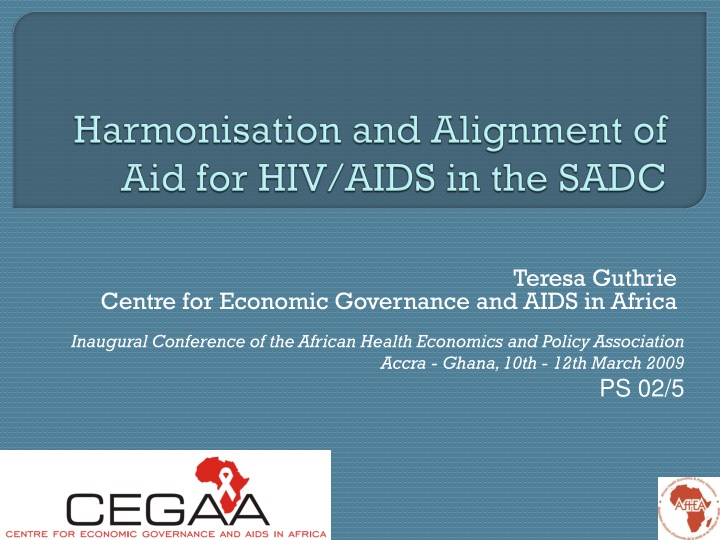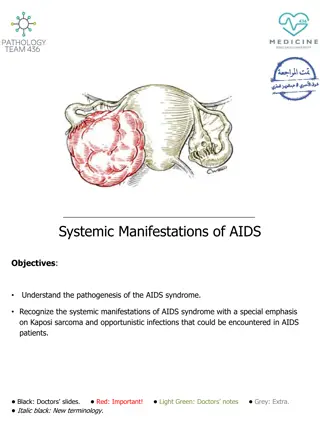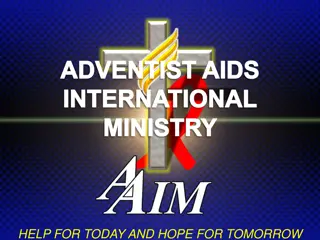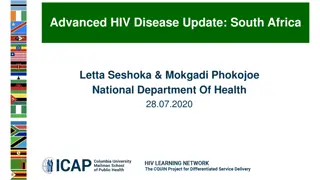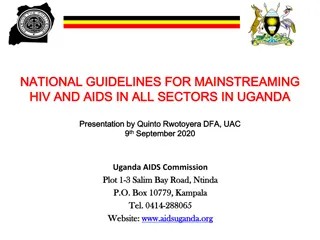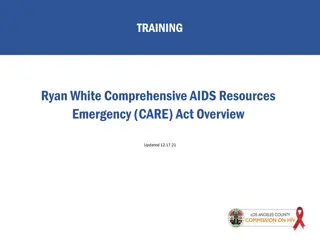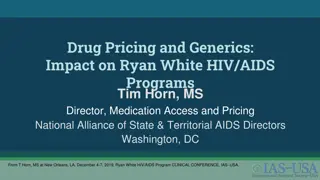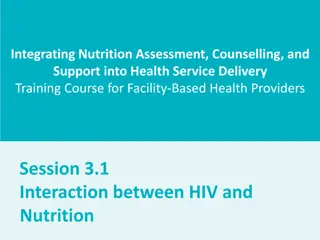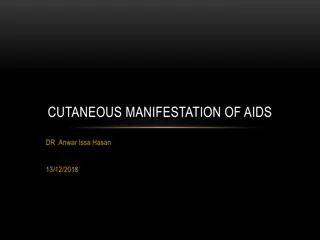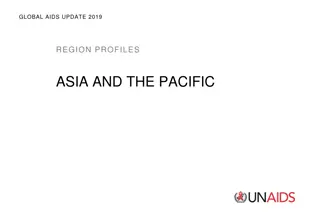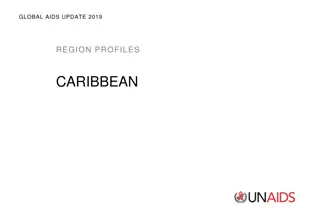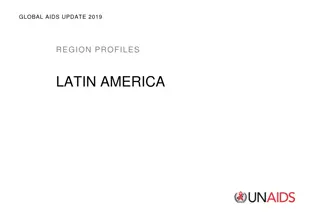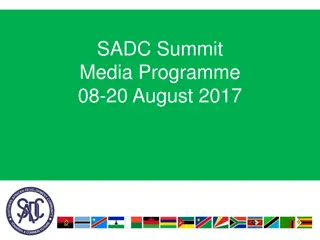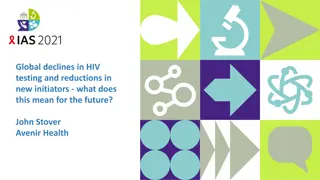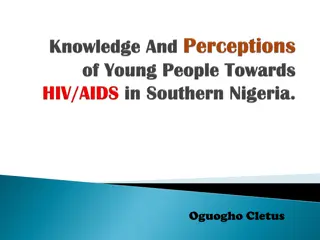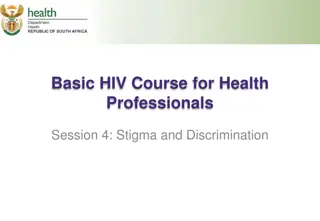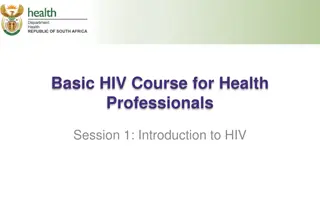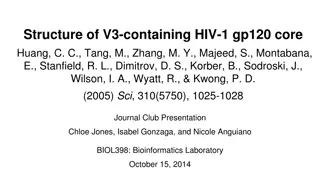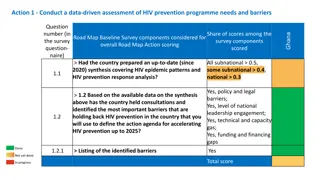Progress and Challenges in Harmonising HIV/AIDS Funds in SADC Region
Incidence of HIV/AIDS in the SADC region has been steadily increasing, with 15 million HIV-positive individuals. Member states have implemented measures at national and regional levels, including multi-sectoral plans and commitments to various frameworks and declarations. Efforts have been made towards resource mobilization, fund establishment, and budget allocation for health.
Download Presentation

Please find below an Image/Link to download the presentation.
The content on the website is provided AS IS for your information and personal use only. It may not be sold, licensed, or shared on other websites without obtaining consent from the author.If you encounter any issues during the download, it is possible that the publisher has removed the file from their server.
You are allowed to download the files provided on this website for personal or commercial use, subject to the condition that they are used lawfully. All files are the property of their respective owners.
The content on the website is provided AS IS for your information and personal use only. It may not be sold, licensed, or shared on other websites without obtaining consent from the author.
E N D
Presentation Transcript
Teresa Guthrie Centre for Economic Governance and AIDS in Africa Inaugural Conference of the African Health Economics and Policy Association Accra - Ghana, 10th - 12th March 2009 PS 02/5
To assess the progress of SADC countries towards harmonisation & alignment of funds for HIV and AIDS To review the existing declarations & instruments To identify the blocks and challenges To make suggestions for required actions.
Literature review Interviews with key respondents from various SADC countries Used data from country NASA reports, where available
Incidence of HIV/AIDS has been steadily increasing in the SADC region for the last two decades 15 million HIV-positive people in SADC Region 51% of all the infections in Africa are in SADC 37% of the global total are in SADC Thus SADC region is the worst affected in the world
Member states have put in place measures at both national & regional levels for treatment, prevention & mitigation Multi-sectoral strategic plans (NSPs) and strong leadership response Commitment to Abuja Declaration and Plan of Action, the New Partnership for Africa's Development (NEPAD), the Millennium Development Goals (MDG) and the UN General Assembly Special Session of HIV/AIDS Increasing partnerships with International Cooperation Partners (ICPs) - Donor coordination meetings, partnership framework, ICP framework Increasing role of civil society
SADC HIV/AIDS Strategic Framework and Plan of Action: 2003-2007 adopted Underscored the importance of resource mobilization in the fight against HIV/AIDS Approved the establishment of a regional fund for the implementation of the SADC HIV/AIDS Strategic Framework and Programme of Action 2003-2007 Urged International Cooperating Partners and international development finance institutions to generously contribute to the fund Appealed for a relaxation in the stringent requirements attached to accessing these funds on the part of ICPs Members to continue efforts towards allocating at least 15% of their national budgets to health, consistent with the Abuja Declaration.
Difficult to get a regional picture, requires country level analysis and reporting to SADC Not all countries have undertaken NASAs nor accurately costed their NSPs Some countries not aware of all the commitments and disbursements made to HIV/AIDS, and very few aware of the actual expenditure So do not have a clear picture of the resources required, the resources available, and therefore cannot estimate the resource gap & mobilise funds Limited evidence on the extent of absorptive capacity (undermined by above points)
From external, domestic, and some private/ business sector resources Increasing number of actors confusion, fragmentation, duplication, undermining a coherent response Varying funding mechanisms & reporting requirements varying complexity and strengths & weaknesses
Authority is dispersed National priorities are weakened M&E is fragmented Implementation is slowed Duplication, gaps, wastage of resources Poor absorption Impact is limited
Aid Effectiveness Harmonisation and alignment Existing declarations, instruments, tools Country efforts
Aid harmonisation refers to the creation of common arrangements for managing foreign aid. It requires that donors should work together to ensure that their systems and processes are standardised to reduce transaction costs to the recipient government . (AFRODAD, 2007).
The adoption of common procedures: Use the national government budget process (direct budget support) Use the government accounting and procurement systems, Undertake joint: aid missions to a country diagnostic studies (sit.analysis) monitoring, auditing and evaluation processes
2002 Monterrey - conference on Financing for Development 2003 Rome: High-Level Forum on Harmonization 2003 ICASA: The Three Ones conceptualized 2003 Maseru: HIV/AIDS Summit 2004 Washington: Harmonization of International Funding 2004 Tanzania: Africa Region Workshop on Harmonization, Alignment and Results 2005 Paris: Declaration on Aid Effectiveness 2005 London: Global Task Team established 2005 Rio: Three Ones Consultative Workshop 2006 Paris:Innovative Financing for Development 2006 Rwanda: Harmonisation, Alignment and Aid Management
goes beyond previous agreements by attempting to lay down a more practical, action- oriented roadmap to improve the quality of aid and its impact on development (AFRODAD, 2007). 5 five key principles: ownership alignment harmonisation managing for results mutual accountability establishes a commitment to track and set targets against 12 indicators of progress.
Joint Assistance Strategies (JAS) or Development Aid Strategies (DAS) for aid mobilization, coordination and utilization (eg. Zambia, Malawi, Tanzania). Aim at increasing efficiency and effectiveness in the mobilisation and utilisation of aid to achieve development goals Number of reforms, such as the establishment of new aid coordination mechanisms, which causing an increase in the number of structures that that manage aid in the country. Aid and Debt Policies Public Financial Management (PFM) reform Support for the PFM agenda/ Action Plan Regular stakeholder dialogue forums, partnership forums Increasing joint approaches: Planning, Reviews and analytical work, SWAp, Direct budget support, Pooled funding common funds.
Spending Priorities 2005 HIV- and AIDS-Related Research Community Development & Enhanced Environment 1,200,000,000 1,000,000,000 Social mitigation 800,000,000 Human Resources for HIV and AIDS activities Pula 600,000,000 Prog.Devmt & HSS strengthening 400,000,000 Orphans and Vulnerable Children (OVC) 200,000,000 Treatment and care components Total 0 Prevention Programmes Public sector Internat.Orgs Grand Total
Strengthen Legal & Ethical Enviro. 0 0.5 Psychosocial & Economic Impact 17 22.2 NSF Goals Mgmt of National Response 7 14.4 Care & Support (incl ARVs) 54 49.4 10 Prevention 13.6 0.0 10.0 20.0 30.0 % 40.0 50.0 60.0 NSF % Actual Spending %
Factors undermining One National Framework: NSP is often disregarded by the various actors National target setting might be unrealistic May be due to accommodating civil society demands NSP are not well costed, leading to an under- or over-estimation of resources required Donors continue to fund direct projects, which may be on or off the plan, and which they may or may not report on Civil society groups may not buy-in to the NSP nor feel the need to report on their activities and expenditure
Factors undermining One National Coordinating Authority Donors still have their own agendas and interests, not consulting with NACs Duplication and parallel systems of CCMs and National AIDS Authority Staff shortages and gaps in the NAC, in the MoH and MoF Civil society has role to hold govt and donors accountable, but should also be accountable to NAC Power is not given to NACs to manage the funds
250,000,000 200,000,000 150,000,000 125,448,618 External Agents Other Local Agents Public Agents Amount 100,000,000 95,275,143 33,975,810 50,000,000 19,005,985 48,484,816 26,285,518 0 2005 2006 Year
Factors undermining One M&E system: Lack of capacity in M&E Financial reporting weak - Many NACs are not aware of what has been spent on the HIV/AIDS national priorities Donors continue to have individual programme monitoring & reviews, and separate auditing requirements imposed on recipient Governments Failure of national budget & accounting systems to link expenditure with HIV/AIDS priorities The activities & outputs of civil society are generally not included in the national M&E system (eg. Swaziland has specifically developed the SHAPMoS but CSOs are resisting)
Factors undermining unified systems and procedures: The Public Finance Management reform is progressing slowly, leading to a lack of trust in Govt. systems & donor cynicism The national procurement, auditing and accounting systems are weak, or perceived to be weak by donors Some donors systems are inflexible, preventing rapid alignment Governments do not provide clear guidelines on scheduling and conduct of missions, nor demanding joint missions Creating an optimal combination of DBS, Sector Support, Basket Funding (what really contributes to harmonisation?)
NAC/ governmental roles: NSP should be a living document that guides the national response (responsive, involving all stakeholders, buy-in, engendered) Governments to own and lead the response to HIV/AIDS Governments to better define the rules of engagement with partners Develop a clear agenda for action, reflecting mutual accountability, building on countries' own systems, with clear allocation of responsibilities for all parties (govt, donors, civil society) NSP should be realistically costed, and expenditure against the priority activities should be tracked Establish and maintain structures for regular dialogue with all stakeholders
Increase/ demand for more joint approaches: Planning, Reviews and analytical work, Direct budget support, SWAp, Pooled funding, baskets Government and donors and civil society to agree on a common framework for financial performance monitoring, strengthen economic governance systems Design and implement a system of assessing donors based on Paris Declaration norms eg. Donor Score Card Government to formulate and implement an Aid Coordination Calendar (donors to align their fiscal year) Sector ministries to articulate work plans for their contribution to the HIV/AIDS national priorities All levels of govt to enhance their own accounting, reporting and transparency regarding fund utilisation this will increase donor confidence and willingness to align and encourage civil society accountability
ICPs roles Increase predictability of donor funding (longer-term commitments), with greater flexibility More funding for general health systems strengthening More support for the construction of solid national authorities and coordination capacity Emphasis on human and institutional capacity building Accept and use the national M&E and reporting systems Harmonize reporting requirements, tools and indicators Donors to use national systems for procurement, accounting and auditing Closer exchange and effective dialogue between Global Fund and UN Emphasis on strengthening govt. financial information systems, so as to enable electronic timeous reporting on expenditure and easily available data (computerised systems reporting according to NASA categories)
SADC Roles: Strengthened communication channels and mechanisms for sharing info across SADC and between NACs sharing best practices Strengthened position if negotiating as SADC Spearhead the development of a Code of Conduct for all partners, particularly relating to ICPs alignment with NSPs (eg. Donor Score Card) Fund for the response to HIV/AIDS? Hold joint annual reviews of progress towards harmonisation and alignment with all stakeholders Request regular commitment & expenditure reports from Members to create the regional funding picture Regional group to consider/ monitor regional funding issues Encourage Members use of the RNE, NASA and CHAT tools
Civil Societys roles: Civil society could broaden its advocacy focus to include processes such as alignment and harmonization Generate more public debate on alignment to drive the access agenda delivery of Universal Access relies on effective architecture making the money work Demand the govt and ICP reveal their actual expenditure in-country Reveal their own activities and expenditure leading to improved governance and greater transparency (eg. recent Declaration on Good Governance and Leadership) Demand greater transparency of adherence to promises Increased financial contribution from the private sector
International Health partnership and related initiatives (IHP+) is a collective commitment to work together in more effective ways to improve health care Rationalising of the health architecture Change in the way donors work together with partner countries through coordinated efforts of all stakeholders the strengthening of in-country health system services under the leadership of the Government, acting with the representatives of civil society
To prove the impact of the IHP+ will require strong, transparent financial information & accounting systems by governments. Spending of pooled funds is difficult to track to the specific donor ~ adoption of single reporting by govt without individual outputs reflected. Public contributions to health are key to sustainability of programmes, and therefore donor-dependency must be addressed. Evidence of basket funding for HIV/AIDS and Partnership Forums donors maintain dominance in determining spending priorities, and can gang up against govt. Are donors ready to allow governments full determination of the use of funds? Will funding for critical NGO services reduce?
Teresa Guthrie Centre for Economic Governance and AIDS in Africa teresa@cegaa.org +27-82-872-4694
